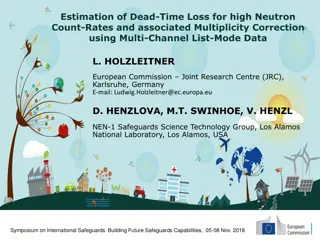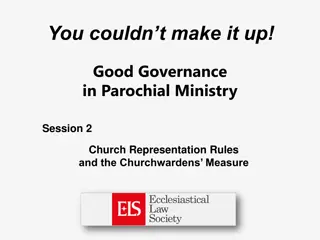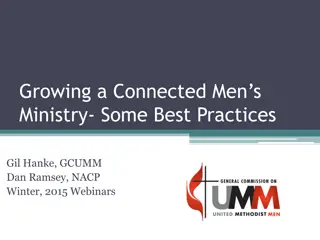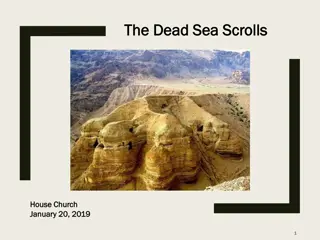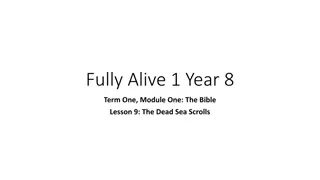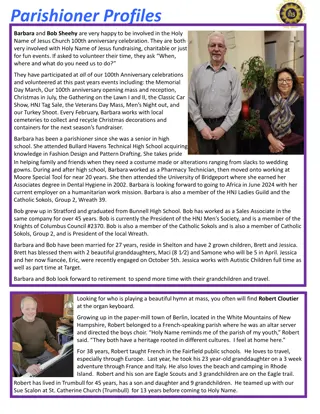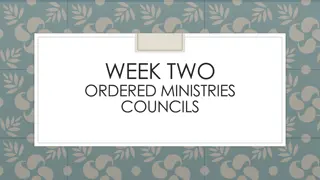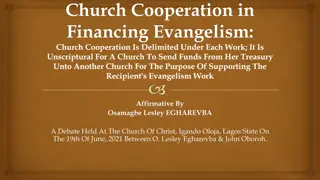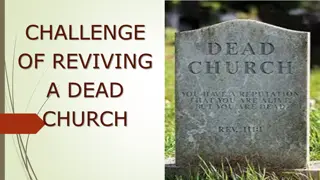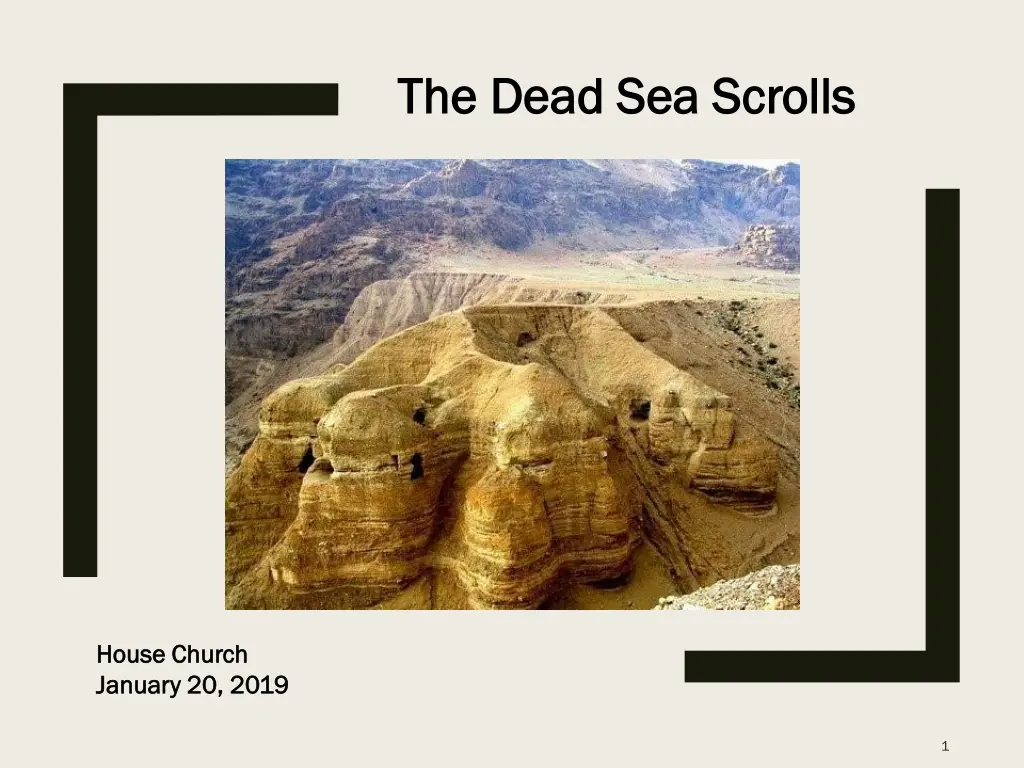
Dead Sea Scrolls: Discovery and Significance
Unveil the intriguing tale of the Dead Sea Scrolls, from their accidental discovery by Bedouin goatherds in 1947 to their profound implications on history and religion. Explore the historical context, the preservation efforts, and the scholars' reactions to this remarkable archaeological find.
Uploaded on | 0 Views
Download Presentation

Please find below an Image/Link to download the presentation.
The content on the website is provided AS IS for your information and personal use only. It may not be sold, licensed, or shared on other websites without obtaining consent from the author. If you encounter any issues during the download, it is possible that the publisher has removed the file from their server.
You are allowed to download the files provided on this website for personal or commercial use, subject to the condition that they are used lawfully. All files are the property of their respective owners.
The content on the website is provided AS IS for your information and personal use only. It may not be sold, licensed, or shared on other websites without obtaining consent from the author.
E N D
Presentation Transcript
The Dead Sea Scrolls The Dead Sea Scrolls House Church House Church January 20, 2019 January 20, 2019 1
The Dead Sea Scrolls The Dead Sea Scrolls Introduction The Discovery of the Scrolls What Was Found? What Is a Scroll? Who Wrote the Scrolls? Dating the Scrolls: 200BCE-100CE Preserving the Scrolls Assembling Scroll Fragments Translating the Scrolls Why Are the Scrolls Significant? The Scrolls and Christianity 2
Discovering the Scrolls Discovering the Scrolls Historical Context: 1947, Palestine (west of Jordan River) is under British Administration (British Mandate, 1923), with Jerusalem as its Capital. Two nationalistic movements: Jews vs. Arabs, led to Civil War (1947- 1948) and resulted in partition, establishing (1) the state of Israel, (2) Arab West Bank annexed by Jordan, (3) the Gaza Strip under Egyptian protectorate. Jerusalem is split: East (Jordan), West (Israel). November, 1947. After a particularly rainy season, Bedouin goatherds and cousins Jum'a and Muhammed ed-Dib are grazing their sheep and goats by the caves at the northwest corner of the Dead Sea. Muhammed throws a rock into a cave, hears a crashing sound, and returns to his flock without entering the cave. Two days later, he returns, climbs up into the cave and makes what will become one of the most important archeological discoveries in history. Inside the cave, he finds four jars. The first three are empty. He opens the fourth and is repelled by a terrible odor, but when it dissipates, he reaches in and finds four scrolls. The cousins bring the scrolls to their tent near Bethlehem and, having no idea what they ve found, they unroll them and hang them on a tent pole, where the scrolls remain for several weeks. One scroll (The Community Rule) splits in half. The cousins and their friends bring the four scrolls to an antiquities dealer in Bethlehem, who considers them worthless forgeries. Finally they approach Khalil Eskander Shahin (Kando), who shows interest and tells the cousins to go back to the cave to see if there are more. They go back and find three additional scrolls. They return to Kando and sell him the first four scrolls for $4, then go to another antiquities dealer Sahili, who buys the other three. Kando (with the four scrolls) has a Syrian Christian friend in Jerusalem who thinks that his Bishop, Athanasius Yeshue Samuel might be interested. Kando sells his four scrolls to the Bishop for $64. Bishop Athanasius contacts John Trevor, President of the American Schools of Oriental Research (ASOR), and delivers the scrolls to him for evaluation. Trevor opens the first, recognizes it as the Book of Isaiah, sees that it is written in an ancient script and considers it unique, perhaps the oldest existing manuscript of a biblical book. He photographs the four scrolls and send the photos to Professor William F. Albright (world s preeminent archeologist, Johns Hopkins University) who, after reviewing the photos, describes their discovery as the Greatest archeological find of the 20thCentury. About the same time, Hebrew University Professor Eliezer Lipa Sukenik hears that Sahili has the three other scrolls and travels (sneaks) from Jerusalem to Bethlehem to see them. He immediately recognizes the scrolls as ancient Hebrew Scriptures and purchases them (see his reaction on the next slide). 3
Discovering the Scrolls Discovering the Scrolls My hands shook as I started to unwrap one of them. I read a few sentences. It was written in beautiful biblical Hebrew. The language was like that of the Psalms, but the text was unknown to me. I looked and looked, and I suddenly had the feeling that I was privileged by destiny to gaze upon a Hebrew Scroll which had not been read for more than 2,000 years. Hebrew University Professor Eliezer Hebrew University Professor Eliezer Lipa Lipa Sukenik Sukenik 4
Discovering the Scrolls Discovering the Scrolls Meanwhile Bishop Athanasius wants to sell his scrolls, thinks that he can get the best price for them in the United States, transfers them to the Syrian Church of New Jersey, and advertises them in the Wall Street Journal. He can t find a buyer, but when Sukenik hears that the four scrolls are for sale, he sends his young colleague archeologist Yigael Yadin to NY to purchase the scrolls. He meets Athanasius at the Walldorf Astoria, purchases the scrolls for $250,000 and brings them back to Israel. By 1955, all seven of the original scrolls are at the Hebrew University in Jerusalem. In the end, there will be only 11 mostly intact scrolls. In 1949, the Jordanian Department of Antiquities led by Gerald Lancaster Harding and Roland de Vaux undertake the first excavation of Cave 1. Two years later (1951), de Vaux, a team from ASOR (American Schools of Oriental Research) and Bedouins excavate the village of Qumran, a small town near to the caves. The settlement was then thought to be the home of the Essenes, who, due to their proximity to the caves, were immediately considered to be the authors of the scrolls. From 1951-1956, 10 other caves are discovered by de Vaux and his teams. From 1951-1957, all the scrolls and fragments are transferred to the Palestinian Archeological Museum (Rockefeller Museum) in East Jerusalem (Jordan). Here, between 1952-1967, the scrolls and scroll fragments are assembled, studied and translated, by a small international team of 8 scholars, led by de Vaux. These scholars kept the scrolls from the rest of the scholarly world. In 1967, after the Seven Days War, the entire collection comes under the control of the Israelis and is moved to West Jerusalem. Still the same 8-person team continues to exert tight control, until during the 1980 s, under intense international pressure, the scrolls are increasingly made available to the broader international academic community (more about this later). In February 2017, Hebrew University archaeologists announced the discovery of a new, 12th cave. There was one blank parchment found in a jar; however, broken and empty scroll jars and pickaxes suggest that the cave was looted in the 1950s. The blank parchment feeds theories about forgeries that regularly appear on the market (The Bible Museum in Washington, DC). 5
Discovery and Early Authentication of the Dead Sea Scrolls (1947 Discovery and Early Authentication of the Dead Sea Scrolls (1947- -48) 48) John Trevor first scholar to see the scrolls, John Trevor first scholar to see the scrolls, photographs and sends photos to Albright photographs and sends photos to Albright Shepherds Muhammed Shepherds Muhammed edh edh- -Dhib Dhib, his cousin , his cousin Jum'a Muhammed Jum'a Muhammed discover the scrolls discover the scrolls Bishop Athanasius Yeshue Bishop Athanasius Yeshue Samuel, Syrian Christian Samuel, Syrian Christian purchases 4 scrolls for purchases 4 scrolls for $64.00 $64.00 Israeli Hebrew Israeli Hebrew scholar Eliezer scholar Eliezer Lipa Sukenik buys 3 Sukenik buys 3 other scrolls from other scrolls from Bedouins and sends Bedouins and sends Yadin to NY to buy Yadin to NY to buy them them Yigael Yadin, archeologist, Yigael Yadin, archeologist, brings original scrolls to brings original scrolls to Jerusalem; they now reside Jerusalem; they now reside at Shrine of the Book in at Shrine of the Book in Israel Museum. Yadin later Israel Museum. Yadin later Deputy Prime Minister of Deputy Prime Minister of Israel. Israel. Lipa Bishop Samuel comes to U.S. to Bishop Samuel comes to U.S. to sell 4 sell 4 scrolls, sale is at the scrolls, sale is at the Walldorf for $250K to Yigael Walldorf for $250K to Yigael Yadin, who brings them to Israel Yadin, who brings them to Israel Hebrew scholar and Hebrew scholar and archeologist William F. archeologist William F. Albright authenticates Albright authenticates scrolls scrolls 6
Archeologist Roland De Vaux, Excavates Qumran, Archeologist Roland De Vaux, Excavates Qumran, Discovers other Caves (1951 Discovers other Caves (1951- -1056) 1056) Roland De Vaux, Roland De Vaux, leads research leads research into the scrolls into the scrolls until his death in until his death in 1971 1971 7
What Was Found in the 11 Caves? What Was Found in the 11 Caves? Fewer than a dozen mostly intact manuscripts, all found in Caves 1 and 11. 90,000+ fragments, many no larger than a fingernail, that belong to 980+ documents. Over 15,000 fragments were found in Cave 4 alone. More fragments continue to be discovered, some in cigar boxes in the dark corners of the museum (2013)!!! Coins, pottery, textiles and leather from the soles of shoes. Dead Sea Scrolls (DSS), including intact manuscripts and manuscripts reconstructed from fragments: Canonical Books (30% of the entire collection): 225 manuscripts of books from the Hebrew Bible (OT); several copies of every book except Esther (Psalms, 39 copies; Deuteronomy, 33; Genesis, 24; Isaiah, 22; Exodus, 18, etc.). These manuscripts are approximately 1000 years earlier than any previously existing manuscript of a book in the Hebrew Bible (the Aleppo Scroll had been the earliest, approximately 900 A.D.). Noncanonical books (20%): Jewish religious texts not considered a part of the Hebrew Bible, but included as Apocrypha in modern Catholic Bibles (e.g. Jubilees, Enoch, Tobit, Sirach). These are the earliest versions of these books, which previously had only existed in Greek and Latin. Nonbiblical Religious and Nonreligious Books (about 50%). Non-biblical books that provide commentaries on Biblical books, descriptions of the Messiah and what will happen when he returns, rules for synagogues or Jewish communities, and great insight into Jewish religious life from 200 BCE to 100CE (e.g., the Community Rule; the War Scroll, The Copper Scroll, The Temple Scroll). 8
Discovered at Qumran Discovered at Qumran 90,000+ 90,000+ fragments fragments The Great Isaiah Scroll The Great Isaiah Scroll The Copper Scroll The Copper Scroll 9
What Is a Scroll? What Is a Scroll? Consecutive columns of writing on pieces of vellum/parchment, sewn together to make the scrolls. Scrolls were written with black ink (carbon black mixed with olive oil, vinegar or honey), written with a reed pen on untanned animal skins (parchment or vellum); a few manuscripts are written on papyrus, and one on copper (a buried treasure map). Four types of animal skins were used (goat, calf, gazelle and ibex) Calf and goat were used for scrolls of greater significance Gazelle and ibex were used for scrolls of lesser significance Based on animal type, the thickness of the skin was an important clue for sorting fragments (discussed below) Written from right to left, with no punctuation, no vowels, no space between words. The letters simply run together in a continuous stream. This is true of many ancient Greek NT manuscripts (uncials and minuscules). Most of the scrolls were written in an old form of Hebrew; one of six were written in Aramaic; a few in Greek, and four in Cryptic Script (code), that was easily decoded. 10
Who Wrote the Scrolls? Who Wrote the Scrolls? Qumran and the Standard Model Qumran and the Standard Model The Essenes, an ascetic Jewish sect, who occupied Qumran from 200 BCE-70CE wrote the texts and stored them in the caves Supported by Josephus and original archeology by de Vaux Palestinian Jewish authors including Qumran Essenes Palestinian Jewish authors including Qumran Essenes Josephus and de Vaux s archeology questioned Based on handwriting, more than 850 authors (also important for sorting fragments), many more than could have lived a Qumran Many texts describe Jewish religious community life outside Qumran. Some are teaching manuals for leaders who are starting new synagogues Written by Jews, some books may have been kept in libraries of the Temple in Jerusalem, moved to the caves for safe-keeping when Jerusalem was invaded by Romans (70 CE) Provide a broad and diverse view of Jewish religious views during period from 200BCE-100CE 11
Dating the Scrolls (200 BCE Dating the Scrolls (200 BCE- -100 CE) 100 CE) Evidence from coins and pottery. Evidence from radio-carbon dating of the animal skins. Initial test in 1951 puts the date at 33 AD +/- 200 years; since then two sets of tests put the dates between 200 BCE-100CE. Paleographic dating, the analysis of the writing, including the forms of the letters, size of the letters and style of writing put the date of authorship in the same range. Internal evidence from the scrolls. Some scrolls describe attitudes and interactions with rulers and other leaders known to have lived during this period of time. 12
Preserving the Scrolls Preserving the Scrolls The scrolls began to deteriorate as soon as they were taken out of the clay jars in which they were stored, out of the caves and away from the arid and low humidity conditions present in the Qumran area adjoining the Dead Sea. At the beginning, lots of mistakes were made handling the fragments: Lighting in the scrollery in Jerusalem faded the fragments that had been arranged under the glass in the tables At first adhesive tape was used to join the fragments, destroying many Every time they moved the fragments, many disintegrated During the 1958 war with Egypt, the scrolls were stored in a damp vault where mildew destroyed many of them Glue from the envelopes in which fragments were stored got on the fragments and destroyed some. By 1990, approximately 20% of the scroll fragments had disappeared; they exist today only in photographs. In 1991, the Israeli Antiquities Authority established a temperature-controlled laboratory for the storage and preservation of the scrolls. Almost all of the DSS collection is currently owned by Israel, and housed in the Shrine of the Book on the grounds of the Israel Museum. The Israel Museum Digital Dead Sea Scrolls website gives users access to searchable, high-resolution images of the scrolls, as well as short explanatory videos and background information on the texts and their history. 13
Assembling the Scrolls Assembling the Scrolls Sorting 90,000 fragments into 950+ documents Complicated by small size of fragments, illegibility or fading of writing, multiple copies of the same document Work is very slow and continues to this day Early work done in Jerusalem scrollery (see photo) Initial sorting done by handwriting analysis. Over 850 separate scribes, with distinct styles of writing Thickness of animal skin Photography of fragments made the text stand out (more readable) Pieces that seemed to fit together based on above criteria were grouped on long table and placed under glass. During the 1980s, opportunities to work on the DSS were expanded to a few locations around the world for respected scholars (and their graduate students), who were not among the original group of 8, but had participated in some way in the discovery of the scrolls. In the 1990s, the Scrolls (photographs) we made available to a wider circle of scholars. Beginning in 1993, the United States National Aeronautics and Space Administration (NASA) has used digital infrared imaging technology to produce photographs of DSS fragments. Recently NASA used multi-spectral imaging technique, adapted from its remote sensing and planetary probes, in order to reveal previously illegible text on fragments of the DSS. Scientists with the Israeli Antiquities Authority have used DNA from the parchment on which the DSS fragments were written, in concert with infrared digital photography, to assist in the reassembly of the scrolls. 14
The Scrollery The Scrollery In the Rockefeller Museum in the Palestinian Section of Jerusalem, In the Rockefeller Museum in the Palestinian Section of Jerusalem, scholars worked with 60,000 Dead Sea Scrolls fragments, sorting scholars worked with 60,000 Dead Sea Scrolls fragments, sorting them on tables in a room called the Scrollery. The process of sorting, them on tables in a room called the Scrollery. The process of sorting, arranging and translating these fragments has continued for 70 years, arranging and translating these fragments has continued for 70 years, to this day in locations around the world. to this day in locations around the world. 15
Translating the Scrolls Translating the Scrolls Fragments or manuscripts? If manuscript, proceed to last steps (transcription and translation) For Fragments: Match and group fragments (huge jigsaw puzzle): which cave, which language, handwriting, type of parchment, etc. Take photographs and assign number Working with photographs, try to reconstruct the original manuscript as much as possible Try to read words, identify gaps and fill in gaps Prepare a transcription similar to a typed version of a handwritten letter [brackets where gaps exist] Prepare a (not the ) translation (usually a team) Many words and phrases have no English equivalent Sometimes conjectures about the meaning of idioms Last step in an intricate and frequently uncertain process or reconstruction The best translators are cautious and humble 16
Why Are They Significant? Why Are They Significant? The DSS provide a new understanding about the nature of Judaism in the years leading up to and including Jesus life. Before the DSS, only one ancient historical record written about Judaism during this period: Josephus, The Antiquities of the Jews, a sweeping history from Creation to Josephus time. DSS scrolls provide a new and more comprehensive view of Judaism and the roots of Christianity. Impossible to adequately understand Jesus and the Gospel descriptions of him apart from this background. The DSS push back the date of existing Jewish manuscripts (biblical and nonbiblical) almost 1000 years, demonstrating that the transmission of these texts was incredibly accurate and reliable. Less than 2% deviation. In Non-Biblical religious texts, the DSS also demonstrate that authors took significant freedom to modify texts according to the purpose for which they would be used or for the recipients for whom they were intended. There are some additions and changes to OT Biblical texts, compared to later Hebrew versions, around which Jews and Christians will have to make decisions about the canon of scripture (e.g., should the extra Psalms, the end of Leviticus and other variations be included in the Bible?). There is an increasing search past theological jargon toward the beginnings of our faith and its original meaning. Who was Jesus, who was he originally understood to be, and what was his relationship to God? The DSS provide insight. 17
The Scrolls and Christianity The Scrolls and Christianity The Isaiah Scroll The Isaiah Scroll The Community Rule or Manual of Discipline The Community Rule or Manual of Discipline The Temple Scroll The Temple Scroll Melchizedek Fragments Melchizedek Fragments 18
The Scrolls and Christianity The Scrolls and Christianity Three Insights (a small sample): Melchizedek Fragments and the early ministry of Jesus The Community Rule and the ministry of Jesus The Temple Scroll, Jesus as the Prophet like Moses, and the mission to the Gentiles 19


